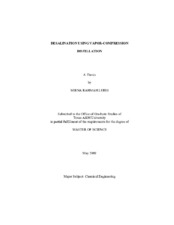| dc.description.abstract | The ability to produce potable water economically is the primary purpose of seawater desalination research. Reverse osmosis (RO) and multi-stage flash (MSF) cost more than potable water produced from fresh water resources. As an alternative to RO and MSF, this research investigates a high-efficiency mechanical vapor-compression distillation system that employs an improved water flow arrangement. The incoming salt concentration was 0.15% salt for brackish water and 3.5% salt for seawater, whereas the outgoing salt concentration was 1.5% and 7%, respectively. Distillation was performed at 439 K (331oF) and 722 kPa (105 psia) for both brackish water feed and seawater feed. Water costs of the various conditions were calculated for brackish water and seawater feeds using optimum conditions considered as 25 and 20 stages, respectively. For brackish water at a temperature difference of 0.96 K (1.73oF), the energy requirement is 2.0 kWh/m3 (7.53 kWh/kgal). At this condition, the estimated water cost is $0.39/m3 ($1.48/kgal) achieved with 10,000,000 gal/day distillate, 30-year bond, 5% interest rate, and $0.05/kWh electricity. For seawater at a temperature difference of 0.44 K (0.80oF), the energy requirement is 3.97 kWh/m3 (15.0 kWh/kgal) and the estimated water cost is $0.61/m3 ($2.31/kgal). Greater efficiency of the vapor compression system is achieved by connecting multiple evaporators in series, rather than the traditional parallel arrangement. The efficiency results from the gradual increase of salinity in each stage of the series arrangement in comparison to parallel. Calculations using various temperature differences between boiling brine and condensing steam show the series arrangement has the greatest improvement at lower temperature differences. The following table shows the improvement of a series flow arrangement compared to parallel: ?T (K) Improvement (%)*1.111 2.222 3.333 15.21 10.80 8.37 * Incoming salt concentration: 3.5% Outgoing salt concentration: 7% Temperature: 450 K (350oF) Pressure: 928 kPa (120 psig) Stages: 4 | en |


